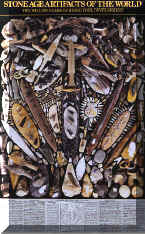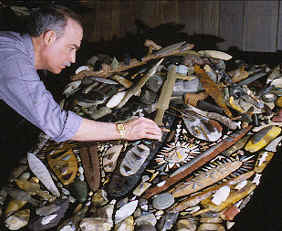LITHIC
CASTING LAB
Pete Bostrom
The following article will offer some background information about Lithic Casting Lab and how it began. It's from a 1998 April issue of "Mammoth Trumpet." A publication that is devoted to the study of the Earliest Americans and published by The Center For The First Americans.
THE Art OF PRESERVING ANCIENT SKILLS
The "Stone Age Artifacts Of The World" picture will probably
always be my favorite. It took two weeks to lay out. But it also took months to coordinate the project,
working with large and small collections from
across the country. The largest collection was the Smithsonian Institution
and the smallest were private collections. What is most exciting about this picture is that these artifacts represent a span-of-time
in which all humans have existed. They also show how complex stone tool
technology really was. There are two bifaces (large blades) in this
picture, the "Sweetwater Biface" and a 24" biface from Mexico that no one has yet been able to duplicate in
modern times. They are good examples that illustrate how skillful some of
these early flintknappers were in making stone tools.
The entire Industrial Revolution has only lasted no more
than the life time of two people, if they lived to the oldest age and
back-to-back. But the Stone Age lasted for millions of years. If it wasn't
for the long lasting durability of stone our knowledge of the past
would be greatly diminished.
"The
Art Of Preserving The Past"
April 1998
"Mammoth Trumpet" By Carol Ann Lysek
(Abbreviated Version)
If you were to visit the world's largest repository of molds and master
molds of important Stone Age tools you would have to travel through the
southern Illinois cornfields to Troy, Illinois, for it is there that Pete
Bostrom operates his Lithic Casting lab.
Known internationally in archaeological circles for the
high quality of his casts of Stone Age artifacts, Bostrom has devised many
of his own methods in what has evolved into a complex multi-step casting
process that ultimately results in molds, master molds, and finished casts
that look almost exactly like the original artifacts. Bostrom believes he
is probably the only person doing this specialized craft as a full time
occupation.
The Lithic Casting Lab "has in the past"
specialized in the replication of prehistoric stone artifacts for museum
displays, teaching aids, reference collections, and for special situations
such as casting artifacts that will be damaged when samples are cut from
them for thin-section or obsidian hydration dating analysis. Bostrom has
also molded and cast artifacts that need to be examined under a scanning
electron microscope but will not fit inside the instrument; selected areas
for study can be cut from the cast and the artifact itself is left whole.
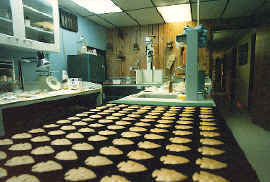


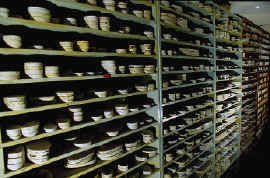
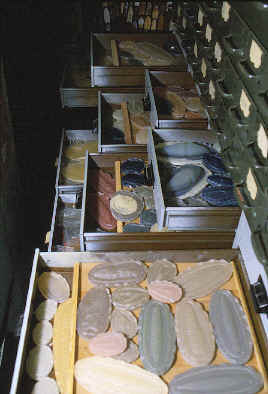
Learning
how to maintain good edge detail and how to cast large items so that they
are detailed and free of air bubbles has taken the 49 year old Bostrom
years of trial-and-error experimentation. He told Mammoth Trumpet that he
has never heard of anyone else doing some of the procedures that he does.
It's an expensive and time-consuming process, but over
the years he has cast hundreds of artifacts from many federal agencies
including Bureau of Land Management, Bureau of Reclamation, Forest
Service, National park Service, and the Smithsonian Institution. He has
done casting projects for a large number of states, counties, museums and
universities. His casts inevitably cause excitement-and-sales among
collectors, flintknappers and within the professional
community.
Bostrom's interest in archaeology dates back to his
childhood. He began surface-collecting artifacts in Illinois in the
early 1970's. After serving in Vietnam, he returned to his job at General
Motors and in 1973 built a 70 by 26 foot building that he used to raise
and sell tropical fish. An influx of fish imported from Asia made fish
breeding impractical, so he returned to his original interest-archaeology.
Bostrom was employed for more than 21 years by General
Motors, and it was only in 1987 that he took an opportunity to leave and
begin to work full time casting artifacts.
Finding himself interacting daily with Old World and
New World archaeologists, collectors and flintknappers, Bostrom learned
that these four groups often have conflicting points of view, but he says
that each has something valuable to offer.
The most unusual cast that Bostrom ever did was a
series of Bigfoot tracks that belonged to the Forest Service. In about
1985 he made molds of three plaster casts of large footprints discovered
in Washington state that showed visible dermal ridges and sweet pores--one
of the prints showed a flexible foot bending around a rock. Bostrom is
amazed at the number of people he meets who have stories about Bigfoot. He
says they make for great campfire conversations.
Bostrom has accumulated thousands of master molds and
casts of artifacts from cultures worldwide over a 25-year period. At least
46 Paleo-Indian sites are represented in the collection, including Mesa
and Moose Creek, Alaska; Blackwater Draw, Colby, Domebo and Drake in the
West; Bostrom and Kimmswick in the Midwest; Dutchess Quarry Rock shelter,
Thunderbird and Vail in the East. He also has molds of artifacts from
important Old World sites such as Abbeville in France, Kalambo Falls in
Zambia, Mezhirich in Ukraine and Olduvai Gorge in Tanzania.
Years ago Bostrom decided that he also needed to make a
photographic record of some of the more uncommon artifacts that were
coming through his laboratory. He has perfected a method for depicting
both sides, as well as an edge view of an artifact, in a single
photograph. Using a large-format camera, he takes a triple exposure on a
4x5 negative. He then transfers the image to a slide that presents the
'impossible" perspective of all three views at once. He uses an 8x10
inch camera when photographing artifacts.
